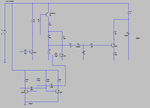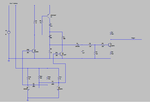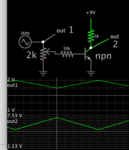miso156
Junior Member level 2
Hello,
I need to scale a DC voltage from range <1 - 2V> to range <1 - 7V>. I can use a single transistor amplifier circiut, becouse I need also inverse this signal.
But what I am interested is if have enough voltage level on input (more than 0.7) if is an R17 need, another words, if I can use an second circuit?
Any stability issue can occur or some another problem?
Thank you

I need to scale a DC voltage from range <1 - 2V> to range <1 - 7V>. I can use a single transistor amplifier circiut, becouse I need also inverse this signal.
But what I am interested is if have enough voltage level on input (more than 0.7) if is an R17 need, another words, if I can use an second circuit?
Any stability issue can occur or some another problem?
Thank you





